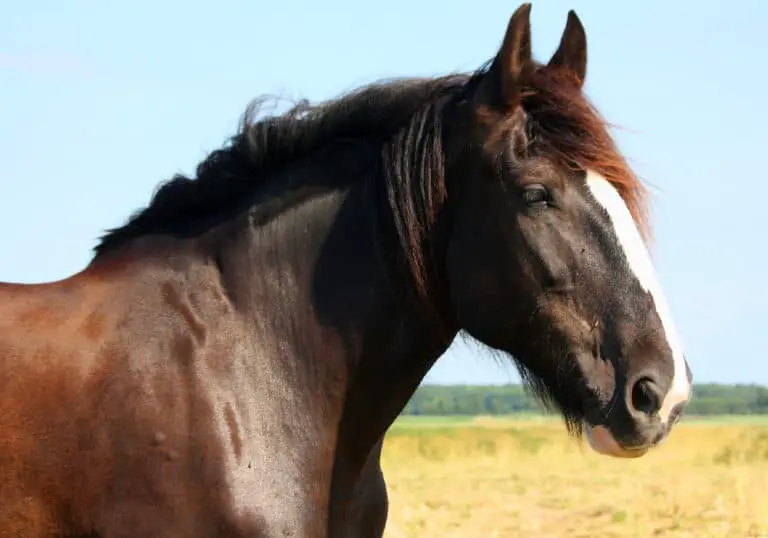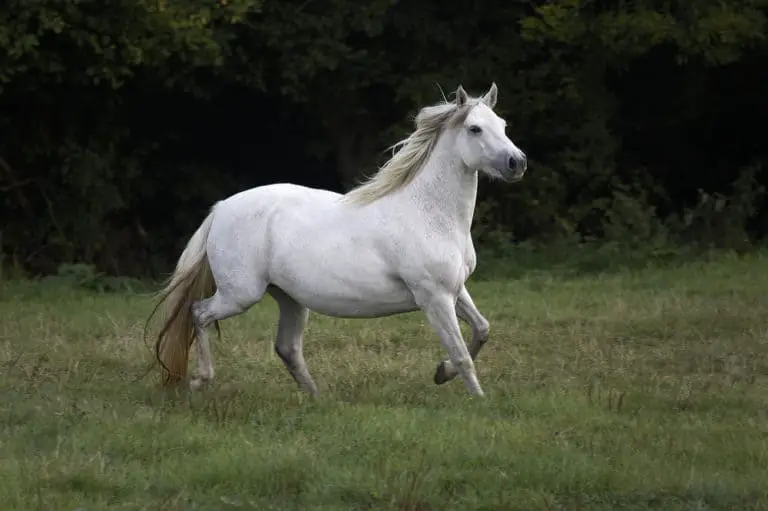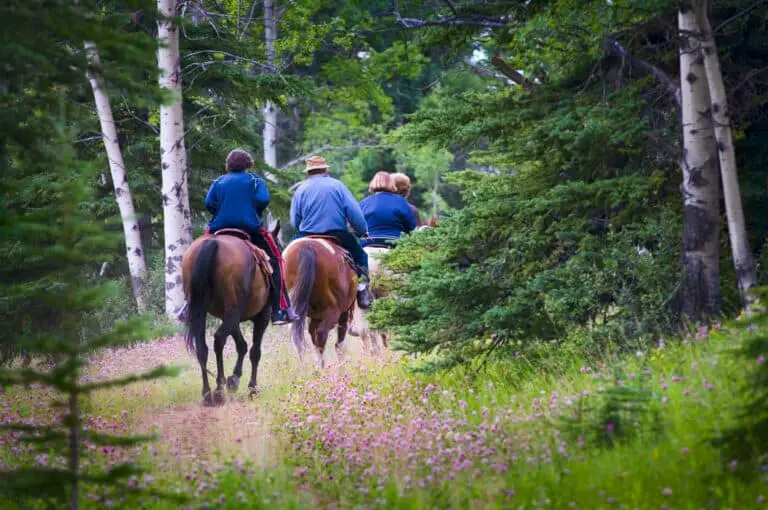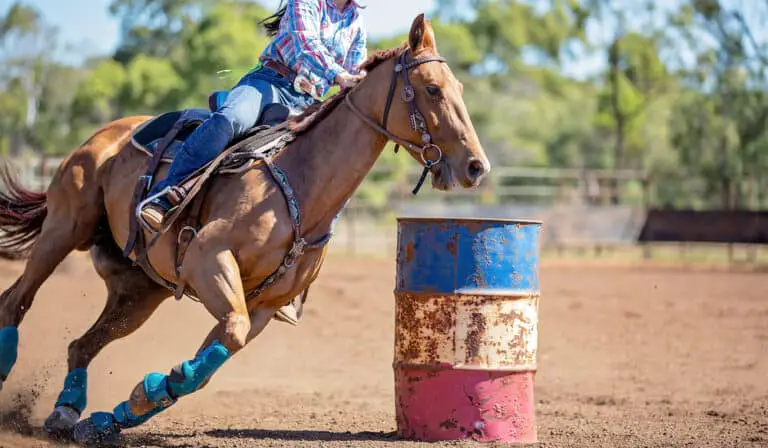Lipizzan Horse Breed: Care, Cost & History (2025)
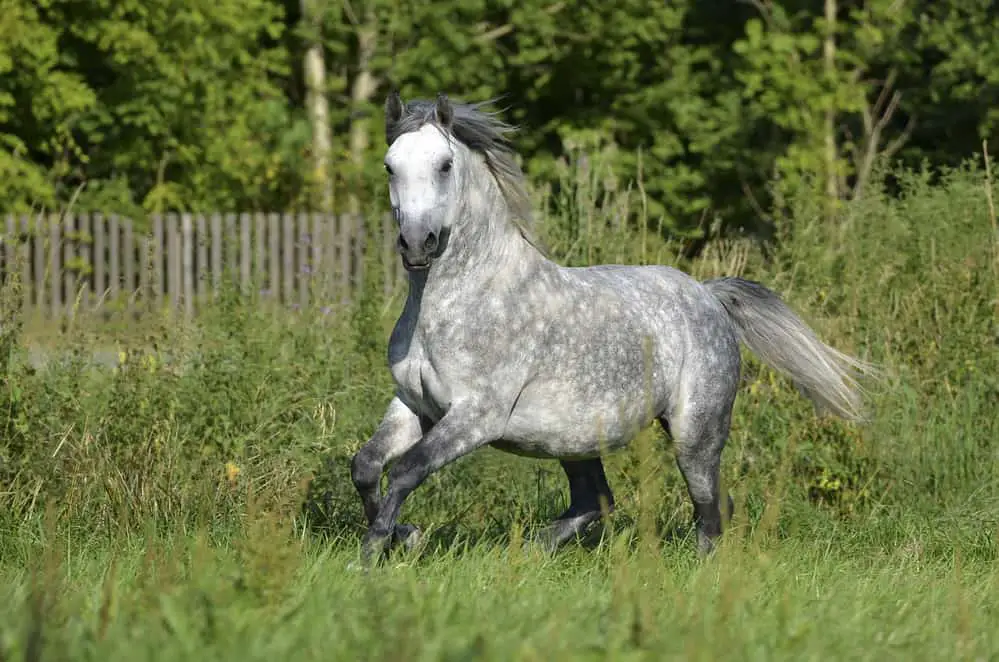
The Hapsburg Monarchy gathered the finest horses they could find in all of Europe and sent them to the Lipica Stud in Slovenia. Here, they carefully bred their horses and created the Lipizzan horse. The breed is known for its grey color, focus, and ability to perform high school dressage exercises.
Breed: Lipizzan horse
Adult Weight: 1,000-1,300 pounds
Adult Height: 15.1-15.2 hands (61-62 inches)
Origin: Slovenia, Spain, and Austria
Use: Dressage, classical riding, show, driving
Colors: Grey, occasionally brown and black
Features: sub convex nose/profile, rounded outlines
Lifespan: 20-30 years
Character: Noble, friendly, willing to work, and like humans
Gait: Elegant and elevated, long strides
Best for: All levels of riders
- Characteristics
- Lipizzan Care
- Lipizzan History
- Modern Lipizzan
- Cost and Ownership
- Buying a Lipizzan
- Similar Breeds
Lipizzan Horse Characteristics
The Lipizzan horse head is distinct in its sub-convex profile, with a large, dark, and expressive eye. The head is a moderate size and proportional to the rest of the body. Lipizzan horse characteristics include rounded features, an arched neck, sloping neck, long back, and well-muscled legs. The overall appearance of the horse is noble, kind, and elegant.
Size
Lipizzan size is very uniform. The breed standard states that horses are between 15.1 and 15.2 hands tall, or 61 to 62 inches tall at the withers. (1) Lipizzan horse height is considered small, especially in contrast to other Warmbloods and European breeds. Horses that are taller or shorter than the breed standard must adhere closely to type standards.
The Lipizzan breed is incredibly athletic and this smaller stature may actually be an advantage in performing classical dressage and high school movements.
The Lipizzan foal reaches 73% of its mature height at three months of age, and according to the breed organization, will be full-grown at six years old.
Weight
Lipizzan horse weight ranges from 1,000 to 1,300 pounds in adult horses. Males weigh slightly more than females, as a general rule. The weight is well proportioned throughout the horse’s body and they have a sleek and muscular appearance.
The foal is born at around 100 pounds and gains 50% of its adult weight by the time they are six months old. The full weight is achieved by age six at the latest.
The legs, and forearm in particular are muscular. The bone structure of the breed is solid bones that are clean and well-defined. The joints also have regular angles and flexibility.
Colors
Size is not the only feature where the beautiful Lipizzan horse is incredibly consistent. They are also uniform in color. Mature horses are almost all grey in color, although Lipizzan horse colors begin darker when they are foals, and then gradually turn grey as they age.
They are sometimes referred to as white horses but they are actually grey. They have the dark eyes and skin of grey horses, with the white hair coat.
Rare Lipizzan horse colors in the adult hose are brown and black. The Spanish Riding School always has at least one bay horse. Any other colors in adult horses are not supported or promoted by the breed organizations.
Temperament
The Lipizzan horse temperament is considered noble and kind with an incredible ability to concentrate. The high degree of concentration the horses have is one of the reasons they are so successful with upper-level dressage movements.
Lipizzan horse behavior is friendly and kind towards people, and this makes them good for all levels of riders, and forgiving of beginners. They also easily make friends with other animals including cats, chickens, and other livestock.
The Lipizzan horse breed doesn’t have its own rules with the United States Equestrian Federation and instead follows the general rules. These state that children are not allowed to exhibit stallions. (2)
Lipizzan Horse Care
Caring for a Lipizzan horse is a commitment, as it is with any animal. They require basic care but don’t have any major health issues. The Lipizzan horse lifespan is between 20 and 30 years, so it’s also a long-term commitment. However, with good basic care, you can enjoy riding your Lipizzan horse for many years.
Diet and Nutrition
The Lipizzan diet is similar to the requirements of other horses. All horses have basic needs of water, carbohydrates, protein, fats, vitamins, and minerals. Most of their dietary requirements are met through free-choice access to fresh, clean water, hay, grass, grain or concentrates, and supplements. (3)
The amount the horse eats will vary depending on their life stage – young, growing horses and pregnant mares have more nutritional requirements. The amount of work a horse is doing will also increase its daily diet. Horses will drink up to 15 gallons of water, or more, each day. They also need to consume about 1.5 to 2% of their body weight in forage each day. (4)
Health Problems
Overall, Lipizzan horses are very healthy if their basic diet, nutrition, hoof, and veterinary needs are met. This includes keeping the barn clean, preventing horses from mingling with other horses, protecting them from rodents and bacteria, and providing regular hoof trimming and health checks. Adequate feed intake will also help prevent colic, which is the biggest issue most horse owners need to be concerned with. (5)
One of the genetic problems the breed is susceptible to is melanoma. This is an issue for horses with grey coats and usually occurs when the horse is five years of age or older. Regular wellness exams by a veterinarian are the best preventative action for early detection and removal. (6)
Grooming
All horses, and especially the Lipizzaner horse, enjoy being groomed. They are social animals that enjoy humans, so this provides a positive interaction and another chance for them to bond with their people. (7)
Horses should be groomed every day, and since most are grey, it’s especially important to keep up with Lipizzan grooming every day. The grey horses are harder to keep clean but the extra time spent will be enjoyable and strengthen the bond with the horse. (7)
Lipizzans have hard, healthy hooves. But, they still need to be cleaned every day to keep the hoof healthy, prevent diseases like thrush or injuries and check for any issues. (7)
Lipizzan Horse History
The Hapsburg Monarchy started Lipizzan horse history 450 years ago. The privately maintained the breed at their farms in Europe and moved them to keep them safe during wars. Horses were given to others when they moved about during wars, establishing smaller studs at various locations. The Hapsburg Monarchy fell during World War I and horse stewardship transferred too.
Origin
Lipizzan horse origin traces back to 800 AD. Breeds that influenced the Lipizzan include the Barb, Andalusian, Lusitano, Spanish horses, and the Arabian horse.
The Hapsburg Monarchy wanted a horse that was powerful and strong for military work, but also flashy and elegant for regular travel. They brought some of the Andalusian ad Lusitano horses to their Austro-Hungarian empire, which extended into modern-day Slovenia too, and the stud farm was started in Lipizza, with another in Kladrub.
Horses were carefully selected and bred for continuous improvement, and from that, a distinct breed type began emerging. They crossed the horses with the Neapolitan horses from Italy, Arabians, Spanish horses, and Barbs to improve them.
Historic Development
The two stud farms of the Monarchy – Kladrub and Lipizza – bred horses for specific purposes. Horses from Kladrub were heavier and used for carriage work. Horses from Lipizza were lighter and used for riding.
After the Hapsburg Monarchy fell during World War I, the historic development of the Lipizzaner shifted. They had always been privately maintained before this. The Piber Stud in Austria was established. This became the main stud farm after 1920.
Stallions had to prove themselves at the Spanish Riding School in Vienna before they could stand at stud. Mares had to pass rigorous performance testing first as well. This careful breeding has continued until the present times.
Notable Lipizzan Horses
There are many famous Lipizzan horses throughout history, and their performances in Austria and the United States continue building their notoriety. The Lipizzan horse pedigree is one of the reasons that they are famous and its influences are still seen today in the notable horses that continue as breed ambassadors.
Pluto and Company
There are eight stallions who are considered the foundation sires of the modern breed, creating what is referred to as dynasties with their bloodlines. Pluto was a gray Spanish stallion foaled in 1765 who is one of these. The other stallions are Conversano, Maestoso, Favory, Neapolitano, Siglavy, Tulipan, and Incitato. The first six were from the Lipizza stud.
Desert Storm and Achilles
Visitors to Florida have the opportunity to see the Royal Lipizzan Stallions that belong to Gabriella Herrmann in Myakka City, including Desert Storm and Achilles, who regularly perform with her. Herrmann’s family has owned Lipizzan horses for 300 years, and she performs the classical dressage moves, including the levade and airs above the ground.
Neapolitano Nima
Neapolitano Nima was the oldest modern Lipizzaner stallion; he turned 40 in 2019 and received recognition for his accomplishments and birthday celebration. He performed with the Spanish Riding School and the other Lipizzaner stallions for many years before retiring to Piber. He actually knew when audiences were applauding for him and worked for their approval.
Myths and Legends
The Lipizzan horse legends are as old as the breed itself because of their connection to the Hapsburg monarchy, knights, and other royals. They have also been threatened by wars, hidden away for protection, and survived viral epidemics. One of the most notable legends surrounding the breed happened during World War II.
Legendary White Stallions
The dissolution of the Austro-Hungarian Empire after World War I was the end of an era for the Lipizzan horses. The Austrian government kept the stallions at the Spanish Riding School in Vienna and established a new stud farm. Then, World War II came along, and the legendary white stallions in Vienna were threatened once again.
Connection to General Patton
Disney chronicled the heroics that saved them in the 1963 movie, Miracle of the White Stallions. Colonel Alois Podhajsky, the director of the Spanish Riding School, took the horses out of Vienna when it was being bombed. They put on an exhibition for General George Patton with the dancing horse breed and asked for protection for the stallions.
Operation Cowboy
Simultaneously, the breeding stock was in Hostau, Czechoslovakia, along with thousands of other horses. Operation Cowboy rescued 1,200 horses (of these 375 were Lipizzaners) and 400 prisoners of war. General Patton sent Podhajsky to Hostau to oversee the Lipizzan horses as they were driven to safety with the rest of the herd.
Modern Lipizzan Horses
It’s still possible to see the two types of Lipizzan horses, the riding and driving types, although the riding horses are much more prevalent. The many setbacks faced by the breed over the years, including a viral epidemic in 1983 that decreased the population size have maintained it as a rarer breed. However, numbers are growing.
Breeding
Lipizzan breeding happens in several places throughout the world, including Europe and the United States. There are many stud farms throughout Europe that have Lipizzan horses breeding, including in Austria, Romania, Hungary, Slovenia, Croatia, and many other locations.
In fact, the Lipizzans are the national animal of Slovenia and grace coins from the country. Many of the horses bred at all the locations are still used for dressage and riding purposes, although they have other uses too.
Popular bloodlines go back to the dynasties of Pluto and the other foundation stallions of the breed. Educational outreach helps maintain the breed’s dedication and adherence to the bloodlines.
Population
The Lipizzan horse is considered a rare breed. Worldwide, there are only 11,602 purebloods in the Lipizzan horse population. (8) These horses are located in Europe, especially in Austria, at the Lipica Stud in Slovenia, and other locations.
There is also a population of 981 purebred Lipizzan horses in the United States. (8) These are horses that were imported here or bred here by a dedicated group committed to protecting and preserving the breed.
The Lipizzan horse can also be found in Australia and South America. The primary goal of all breeders is to maintain the purity of the bloodlines and the traditions of the breed.
Uses
One of the primary Lipizzan horse uses is classical dressage, in fact, the Spanish Riding School only uses the horses for their famous performances. Other uses of Lipizzan horses include riding horses and driving.
Their ability to concentrate and natural talent make them preferred for dressage work both in-hand and under saddle. These same skills make them good in other disciplines too.
The Lipizzan horse gait is completely balanced at a walk, trot, and canter, and that’s one of the reasons that they are such wonderful classical dressage horses. They also have elevated gaits, showing flexion at the knees and hocks that creates an elegant and proud appearance.
Lipizzan Horse Prices
These horses were bred by royalty, and although you don’t need to be a monarch to own a horse, there is still a significant expense involved. Lipizzan horse prices include the initial purchase price, but then you have additional costs each year to care for the horse, provide the feed required to thrive, and maintain their health.
Purchase Price
The laws of supply and demand pertaining to the horse world too. The purchase price for a rare breed is always somewhat higher than a breed where there is an abundance of horses available.
The purchase price of the Lipizzan horse can be anywhere from $9,000 to $25,000. (9) The cost will depend on the age of the horse, their bloodlines, availability of other horses, and any Lipizzan horse training it has.
Ownership Costs
Each year, the Lipizzan horse cost of ownership is between $1,770 to $12,930. This can get expensive, it’s not just the initial purchase that needs to be considered in the Lipizzan price. It’s also board, feed, and veterinary and hoof care. These aren’t avoidable costs, each is essential, so must be budgeted for.
Board
Horse board varies as much as the types of homes that we live in. Some horses have apartments while others are in grand estates, and the costs vary too. Regardless, the boarding facility needs to be safe and clean with adequate turnout. Lipizzan horse board cost is anywhere from $1,200 to $7,200 each year. (10)
Feed
Feed is the hay, grain, grass, and water that gives our horses their energy and supports their daily functions. The Lipizzan horse feed cost is $250 to $4,380 each year. The range is so large because horses in moderate climates with grass year-round need less while others require almost all hay, which is expensive to purchase. (10)
Veterinary Care
Annual Lipizzan horse veterinary cost is between $250 and $350 for the basics – vaccinations, deworming, and dental care. This all assumes a low-maintenance horse with no special issues. Any accidents or injuries will be an additional cost and could be up to $1,000 per visit. All these ensure the horse remains healthy. (10)
Hoof Care
Lipizzan horse hoof care cost is another essential cost as the horse needs its hooves trimmed and balanced every six to eight weeks. Budget $120 to $1,000 each year for this; horses that need shoes will be on the higher end of that range. The farrier, or person responsible for hoof care, can recommend shoes if needed. (10)
Buying a Lipizzan Horse
The Lipizzan breed is the horse of royalty, but that doesn’t mean they are out of reach for you. That being said, each horse is an individual, and you want one that you “click” with or bond within such a way that you can enjoy a lifelong partnership. Looking at several will help you determine the best horse.
Is the Lipizzan Horse Right for You?
Owning a Lipizzan is right for you if you enjoy classical dressage, focusing deeply on your work, and bonding closely with an animal. These kind, noble horses can help riders advance their skills and develop as an equestrian.
Since the breed is kind and people-oriented, they make excellent horses for anyone from a beginner to an advanced rider. When riding a Lipizzan horse, they help the beginner learn finesse and how to develop their skills, while making the advanced rider look seamless and effortless.
The Lipizzan horse could do any discipline, and many have other uses. However, given their history and predisposition to classical dressage, it’s best to focus on uses in this realm.
How to Buy a Lipizzan Horse?
Buying a Lipizzan horse is an exciting journey, but it can be nerve-wracking. Start by talking to a Lipizzan breeder, they can help you create a plan, identify bloodlines that align with your goals and skill level, and identify potential horses for sale.
The purchase process involves identifying multiple horses for sale and going to look at and test all of them. You’ll want to ride the horse, watch it work, and have a veterinary inspection to identify any red flags or potential future problems.
Avoid settling for the first horse you find, and instead, wait and purchase the one that feels like the best match.
Similar Breeds to Lipizzan
It can be challenging to find a Lipizzan horse because they are a rare breed, but not impossible. That being said, there are also Lipizzan breed alternatives, including the Andalusian, Friesian, and Lusitano. All three of these breeds are popular with classical dressage riders. The Andalusian and Lusitano have similar origins, while the Friesian has a striking black color.
Andalusian
The Andalusian, or Pure Spanish Horse, is classical dressage and baroque breed from the Iberian Peninsula. They are elegant, strong, and athletic. Andalusians have a similar height, weight, and appearance to the Lipizzan horse, and are also popular with dressage riders. The breed is closely related to the Lusitano horse as well.
Friesian
The Friesian horse was developed for use carrying knights, and then as carriage horses in the Friesland part of the Netherlands. They are known for their striking black coat, elegant appearance, elevated leg movement, and flowing manes, tails, and feathers on their legs. The Friesian is popular with dressage riders and in driving.
Lusitano
The Lusitano horse breed dates back 20,000 years and developed on the Iberian Peninsula. These Portuguese horses are closely related to the Andalusian and are a baroque breed of horses popular in classical dressage and bullfighting. Grey and black are two common colors, and they also have an elegant and striking appearance.
FAQ
What is a Lipizzan horse?
The Lipizzan horse is a European breed whose classical dressage performances at the Spanish Riding School in Vienna have made them famous.
What does a Lipizzan horse look like?
The Lipizzan horse is a baroque and classical horse. They are grey in color, with a subconvex profile, and rounded features.
How did the Lipizzan horse get its name?
The breed is named for the Lipizza (or Lipica) Stud of the Hapsburg Monarchy where they were originally bred in Slovenia.
Can you ride a Lipizzan horse?
Yes, you can ride a Lipizzan horse and they are known worldwide for the beautiful dressage presentations they perform.
Are Lipizzan horses good for beginners?
Lipizzan horses are friendly, willing to work, and enjoy being with humans, so they can be good for beginners too.
How tall is a Lipizzan horse?
A Lipizzan horse is between 15.1 and 15.2 hands tall at the withers, or 61 to 62 inches tall.
How much does a Lipizzan horse weigh?
The average Lipizzan horse weighs between 1,000 and 1,300 pounds.
How big is a Lipizzan horse?
The Lipizzan horse is considered a smaller breed in stature, in both height and weight, especially when compared with Warmbloods.
How much does a Lipizzan horse cost?
A Lipizzan horse will cost between $9,000 and $25,000, with some costing more or less.
How much does Lipizzan horse ownership cost?
It costs between $1,770 to $12,930 fr Lipizzan horse ownership each year.
How long do Lipizzan horses live?
A Lipizzan horse will live between 20 and 30 years.
How fast can a Lipizzan horse run?
The average speed that a Lipizzan horse can run is 25 to 30 miles per hour.
How much can a Lipizzan horse pull?
A Lipizzan horse can pull between 1,500 and 1,950 pounds.
How much can a Lipizzan horse carry?
Lipizzan horses can carry between 200 and 260 pounds.
At what age is a Lipizzan horse full grown?
A Lipizzan horse is full-grown at six years of age.
What are Lipizzan horses used for?
Lipizzan horses are incredibly popular in classical dressage. They can also be used for pleasure riding, show, and driving.
References
- United States Lipizzan Federation. 2020. USLF Lipizzan Breed Standard. Link
- United States Equestrian Federation. 2022. Licensed Competitions. Link
- UGA Extension. 2013. How to Feed a Horse: Understanding Basic Principles of Horse Nutrition. Link
- The Horse. 2019. Horse Feeding Basics. Link
- The University of Arizona Cooperative Extension. 2022. Tips for Keeping Your Horse Safe and Healthy. Link
- Seltenhammer MH, Simhofer H, Scherzer S, Zechner R, Curik I, Sölkner J, Brandt SM, Jansen B, Pehamberger H, Eisenmenger E. Equine melanoma in a population of 296 grey Lipizzaner horses. Equine Vet J. 2003 Mar;35(2):153-7. doi: 10.2746/042516403776114234. PMID: 12638791. Link
- United States Equestrian Federation. 2017. Basic Horse Grooming. Link
- United States Lipizzan Federation. 2022. Link
- United States Lipizzan Federation. 2022. Horses for Sale. Link
- Arabian Horse Association. 2022. What is the Cost of Providing for Them? Link

